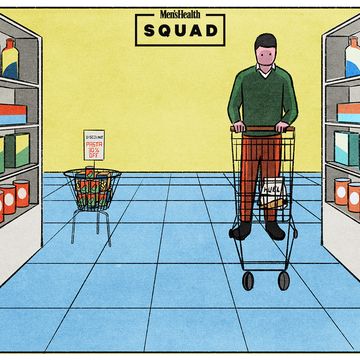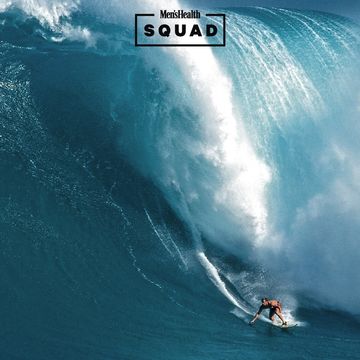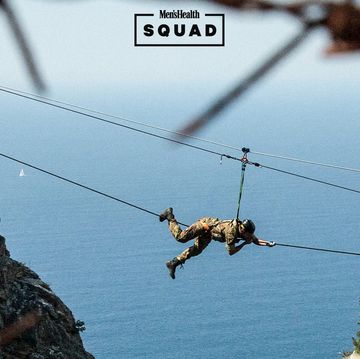Touted as a cutting-edge training aid and the fastest route to increased mass, a new breed of pills called Sarms is outmuscling steroids. The problem? They’re unlicensed and unregulated, and unscrupulous dealers are putting users at serious risk.
Nevertheless, over the past five years, online searches for SARMs (or "selective androgen receptor modulators", including andarine and ostarine) have been rising steadily. Though there's no way to know just how many of us are buying them, analysis of London's famous "fatberg" – the mass of oil and organic matter found in the capital’s sewers – found SARMs present in greater quantities than both MDMA and cocaine.
What's the Difference Between Steroids and SARMs?
Though in some ways similar, steroids and SARMs are not the same. Here’s how they stack up.
Also known as…
Steroids: Deca, Dbol, andro, tren
Sarms: Andarine, ostarine
Generally taken…
Steroids: As an injection
Sarms: In pill form
The similarities:
Both work by binding to your androgen receptors. This triggers changes to your DNA, which ultimately increase your muscle cells’ potential for growth.
The difference:
When you use steroids, enzymes in the prostate and scalp cause the extra testosterone to metabolise into DHT. This binds to your androgen receptors five times more strongly than testosterone, which can lead to issues with prostate health, hair loss and acne. Sarms do not trigger this reaction, and so are said to be “tissue selective”.
Are SARMs Legal to Buy in The UK?
For now. Unsurprisingly, a host of UK-based companies have emerged to meet this rising demand. Some, no doubt wary of any repercussions from selling unlicensed medicines, rely on legal disclaimers, describing their products as “research laboratory chemicals” and warning prospective customers: “Under no circumstances are these products sold for human consumption”. That ought to give you pause for thought.
In 2017, US regulators launched a crackdown on SARMs. Donald D Ashley, director of the Office of Compliance in the FDA’s Center for Drug Evaluation and Research, said: "We are extremely concerned about unscrupulous companies marketing body-building products with potentially dangerous ingredients.” He warned that SARMs were “associated with serious safety concerns, including potential to increase the risk of heart attack or stroke and life-threatening reactions like liver damage”. Here in the UK, however, there has been little public discussion of what should be done.
Are SARMs for Sale Online Safe?
The lack of research isn’t the only problem. An analysis of SARMs products bought online, conducted by the Journal of the American Medical Association found few were the real deal:
48%: Did not contain any SARMs.
39%: Contained other unapproved drugs.
9%: Didn’t contain any active substances.
59%: Had substances in different amounts than stated on the label.
Where Did SARMs Come From?
SARMs were created by accident. In the early Nineties, a scientist named Professor James T Dalton was working on pioneering treatments for prostate cancer when he identified the molecule andarine – the first SARM. It was of little use in treating prostate cancer, but it had a remarkable effect on muscle growth. “It was the opposite of what we were looking for at the time,” he told Men's Health. “But we turned almost all of our attention to this. We knew we really had something unique.”
Several years later, Dalton went on to create a more refined version, known as ostarine. In clinical trials, elderly men given a 12-week course of the drug increased lean muscle mass and reduced fat, while gaining more than a 15% improvement in stair climb power. But a subsequent trial in cancer patients failed to produce the desired results and the drug's development halted. Dalton has since tried to curb the companies operating a black market for his discoveries. “We reached out with cease and desist letters to a couple of them, we reached out to the FDA to try shutting them down," he says. "But it’s rampant and there’s really little that can be done to control it.”
What Are the Side Effects of SARMs?
The evidence here is largely anecdotal. On online forums, users report strength gains, but they also frequently seek advice about issues such as high blood pressure, skin rashes and impotence. Problems with eye-sight appear to be particularly common; andarine is reported to give users’ vision a green or yellow tinge.
Most of the available information online comes from sellers and YouTubers, so there's a tendency for advice to skew positive. Dr Ian Boardley, a senior lecturer in sports psychology at Birmingham University, says: “If someone is using them themselves, it’s in their interest to believe they can use them safely. I think that’s happening with SARMs.” Even if users conduct significant amounts of research into their chosen substances, the conclusions they draw are not necessarily accurate. “One of the things we often see is the distortion and selective use of information to support their behaviour,” he explains. “It’s quite a dangerous process.”
Can SARMs Shrink Your Testicles?
There is, unfortunately, a chance they might. In a study published in the (ominously titled) International Journal of Impotence Research "more than half of SARMs users experienced side effects including mood swings, decreased testicular size, and acne. More than 90% of men reported increased muscle mass and were satisfied with their SARMs usage. Despite having seemingly positive effects, more than 50% of SARMs users report significant adverse effects."
Here, three people talk to Men's Health about their experiences using SARMs. They wanted to remain anonymous.
Case Study #1 – The Personal Trainer
A 37-year-old personal trainer, Allan initially dismissed SARMs as a fitness fad. “There are a lot of supplements that come out on the market that say they do this and that, but the majority of the time they do absolutely nothing,” he says. That changed when he started seeing YouTubers he respected recommending them: “I was sitting up thinking, alright, I’m interested now.” Allan had never taken steroids but, having reached his mid-thirties, was intrigued to discover a supplement that could help him maintain his athletic performance. He placed an order for ostarine, which he’d seen described as one of the mildest SARMs, and started out on what he believed was a small dose.
The problems started almost immediately. Allan took his first dose at lunchtime, then left the house to run some errands before going to the gym. Within hours, he was overcome by a strange sensation: anxious, shaky, a general sense of unease. Allan hoped the feelings would fade; instead, they got worse. “After a few days this anxiety was constant,” he says. “After just over two weeks, that's when I was like, this isn’t for me.” Before giving up on SARMs, he went online to seek advice about his symptoms. He recalls being told: “Man up, you’ll get through it, you’ll be growing in no time.” Instead, Allan decided to follow his instincts: “I’d rather have my mental health intact than have slightly bigger muscles.”
Case Study #2 – The Sports Coach
Andy, a tennis coach in his late thirties, first noticed SARMs being advertised online around two years ago. He recalls seeing them marketed as a “steroid alternative that would give you similar effects”. Andy had been going to the gym for two decades, working out three or four times a week. “I’m always looking at supplements, but I was never going down the steroids route,” he says. “For me, the health risks were always that bit too high.”
Andy began doing further research. He joined Facebook groups, watched YouTube videos, and read scientific papers. “I wanted to make sure, if I was going to do it, it was as safe as it could be,” he says. Around a year after he first heard of SARMs, he ordered ostarine online. Soon enough, he began noticing changes in the mirror. He looked leaner and more muscular. The only downside was some headaches. Andy went on to try another SARM named LGD-4033, which increased his bench curl by nearly a quarter. But after two SARMs cycles, he decided that was enough; he still had lingering concerns about the long-term health implications. “Once there’s more research maybe I would take them longer,” he says.
Case Study #3 – The Gym-Goer
Aaron, a 33-year-old from Stoke-on-Trent, used to use steroids but stopped after suffering severe acne. Two years ago, he saw a YouTube video recommending SARMs, “basically saying they’ve got dead-low risks and all the benefits of anabolic steroids”. His first course of ostarine seemed to work. “I put on quite a bit of muscle, I was really lean, I looked really, really good in a very short time period,” he says. The effects were less dramatic than when he’d taken steroids, but SARMs seemed much safer and the side effects less severe. Aaron placed another order and went on to run three more cycles.
Halfway through his fourth cycle, Aaron noticed an alarming development: his testicles had shrunk. “I just woke up one day and they were gone,” he says. He stopped taking SARMs and began taking hormones in an attempt to kickstart his body’s natural testosterone production. It didn’t work. “I was doing everything I could and they just wouldn’t come back,” he says. “So, I made the decision to turn to anabolics.” Aaron believes he was sold oral steroids under the guise of SARMs, which caused his body’s natural testosterone production to shut down. He’s now resigned to permanently cycling steroids: “I’m ready to do what I’m doing now for the rest of my life.”

















